When it comes to selecting the ideal DC to DC battery charger for your campervan or recreational vehicle, there are several factors to consider. A reliable charger is essential for ensuring your leisure battery remains charged, healthy and ready for use on the go.
In this article, we discuss the key features to look for when choosing a 12v DC to DC battery charger, including output charge current, smart alternator compatibility, input voltage, and supported battery types.
We also explore additional charger features such as MPPT and bi-directional charging, which can improve the efficiency and functionality of your charging setup.
Whether you’re outfitting your campervan with the latest battery technology or simply looking to upgrade your existing setup, our comprehensive guide will provide you with the information you need to make an informed decision.
Keep reading to discover the top six 12v DC-DC battery chargers compatible with various battery types and learn how to optimize your charging system for maximum performance and efficiency.

Trusted Review
Jolly (a self-confessed electrical geek with over 17 years of experience as a qualified electrical engineer) carried out the product comparison review.
Extensive research and honest user experiences have provided the information for this post.
Jolly’s focus now is campervan conversion electrics which started in 2019 with the birth of Vandercamp. Jolly is either building his own campervan or providing electrical help and guidance to others.
Disclaimer
The products reviewed do not sponsor this post. Therefore, the information in this article is our own honest opinion.
This post may contain Amazon affiliate links. Meaning, if you make a purchase after clicking one, we may earn some commission. This pocket money will help Vandercamp Adventures continue to grow at no extra cost to you. It’s a win win situation!! Learn More…
Table of Contents:
Our Pick For Best Campervan DC to DC Battery Chargers (2023)
- Best Overall Charger for Campervans: Renogy 40A DC to DC Battery Charger
- Best For Efficiency: Renogy Rego DC to DC Battery Charger
- Best For Extreme Conditions: Redarc DC to DC Battery Charger
- Best For Connectivity: Victron DC to DC Battery Charger
- Best For External Environments: Ctek DC to DC Battery Charger
- Best For Custom Battery Types: Sterling DC to DC Battery Charger
Comparison Table
| Name | Input Voltage | Charge Current (Amps) | Maximum Cable Size | Warranty | Efficiency | Smart Alternator Compatible | Weight | Size | Price | View | |
|---|---|---|---|---|---|---|---|---|---|---|---|
| Renogy DCC12-12-20/40/60 | 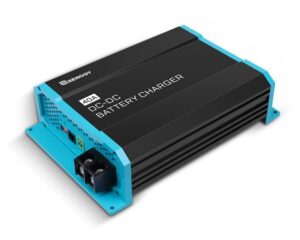 | 8-16v | 20A 40A 60A (10/30A)* | No limit | 1 Year | 90% | Ignition wiring required | 1.3kg 1.9kg 2.4kg | 211x175x68 261x175x68 311x175x68 | £ | View Product |
| Renogy REGO | 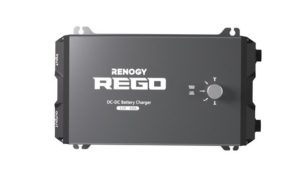 | 10-16v | 10-60A | No limit | 5 Years | 94% | Ignition wiring required | 3.12kg | 354-213-102 | £££ | View Product |
| Victron Orion-Tr Smart |  | 8-17v | 18A 30A** | 16mm | 5 years | 87% | Yes | 1.3kg 1.8kg | 130x186x70 130x186x80 | ££ | View Product |
| Redarc BCDC 1225D, 1240D, 1250D |  | 9-32v | 25A 40A 50A | No limit | 2 Years | Unknown | Ignition wiring required | 1.0kg | 165x120x37 | ££££ | View Product |
| CTEK D250 SE | 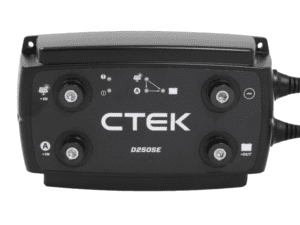 | 11.5-23v | 20A*** | No limit | 2 Years | Unknown | Ignition wiring required | 0.7kg | 192x110x65 | ££ | View Product |
| Sterling BB1230, BB1260 | 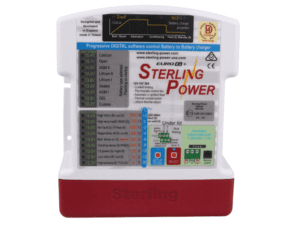 | 12v | 30A 60A | 16mm | 2 Years | Unknown | Yes | 1.2kg 1.4kg | 190x160x50 198x164x71 | ££ | View Product |
Table Definitions
Input Voltage – The voltage accepted from the alternator/starter battery. All chargers here are compatible with 12v inputs.
Efficiency – Energy efficiency of the output charge as a percentage. All electrical devices have energy wastage, usually in the form of heat. The higher the percentage the more efficient.
Warranty – Manufacturer warranty. See the charger details below for their warranty details.
Maximum Cable CSA – The maximum size of cable the charger terminations can accept.
Output Charge Current – The current (amps) supplied to the leisure battery under charge conditions.
Smart Charger Compatible – The charger either has built in voltage sensing software or requires an ignition circuit.
Weight – Overall weight of the unboxed charger
Size – Overall size of the charger (See product manuals for their detailed measurements)
Cost – From £ (cheapest) to ££££ (most expensive). See product for the current price.
The Benefits of DC to DC Chargers
- Charges your leisure battery to 100%, prolonging it’s life.
- The starter and leisure batteries are electronically isolated so won’t drain the starter battery.
- Work effectively with smart alternators unlike voltage sensing relays (VSR) that don’t.
- Set up for different battery types. No need to replace the charger if you change your leisure battery.
- Limited current flow reduces the risk of damage from high in-rush currents.
Who Are The Top 6 Chargers Suited To?
Renogy – Low budgets, novice installers, any size electrical system.
REGO – High budgets, novice installers, any size electrical system.
Victron – Existing victron systems, novice installers, short cable runs (close to the batteries).
REDARC – High budgets, weight/space conscious, extreme conditions.
Ctek – weight-conscious, small electrical systems, lead-acid batteries.
Sterling – Electrical experience/engineer, custom battery setups, smart alternators.
The 6 Best DC to DC Battery Chargers
Renogy DC to DC Battery Charger
Why it made the list: Cheap, Highly efficient, ease of setup.
Renogy provides off-grid electrical systems at affordable prices without compromising on quality. The Renogy DC to DC battery charger is no different; it is the cheapest and one of the most efficient.
It will suit any campervan electrical system with its wide range of output currents from 10-60 amps and unrestricted cable-size terminals. Additionally, its ease of installation and setup will suit novice and experienced installers alike.
However, its lack of automatic voltage detection will require the installation of the ignition wiring, which could be off-putting for some. However, this feature could be advantageous for some, find out why here. Also, it’s one of the heaviest chargers, which is vital for weight-conscious camper builds.
Features
| Input Voltage | Charge Current (Amps) | Maximum Cable Size | Warranty | Efficiency | Smart Alternator Compatible | Weight | Size |
|---|---|---|---|---|---|---|---|
| 8-16v | 20A 40A 60A (10A/30A)* | No limit | 1 Year | 90% | Ignition wiring required | 1.3kg 1.88kg 2.4kg | 211x175x68 261x175x68 311x175x68 |
* Available when using the LC (Current Limiting) charger option.
Pros
- Cheapest DC-DC charger here
- Simple to set up with its DIP switch battery voltage setting.
- High output efficiency
- LC connection allows for wider range of output currents.
Cons
- Requires ignition cable wiring
- 1 year warranty low compared with others
- Technical support issues for non UK and American countries.
Renogy DCC-12-12-20/40/60 manual
Renogy Warranty
1 year material and workmanship – View warranty document
Further Reading | Our Honest Review Of The Renogy 40A DC to DC Battery Charger
REGO DC to DC Battery Charger
Why it made the list: Bi-directional charging, 5 year warranty and ease of setup.
Enhance your campervan conversion with the user-friendly Renogy REGO DC to DC Charger. Its Anderson cable connections and 4-stage charging technology ensure easy installation and optimal battery health. This charger is perfect for novices, offering adjustable charge currents and compatibility with the DC Home app and Renogy One wireless system.
Despite its larger size and weight, the REGO charger provides bi-directional charging, a 5-year warranty, and seamless integration with the Renogy One system. The Renogy REGO DC to DC charger is Bluetooth DC Home compatible meaning you can connect it to the Renogy smart phone app.
Make your van life dreams a reality with this feature-packed charger.
Features
| Input Voltage | Charge Current (Amps) | Maximum Cable Size | Warranty | Efficiency | Smart Alternator Compatible | Weight | Size |
|---|---|---|---|---|---|---|---|
| 10-16v | 10-60A | No limit | 5 Year | 94% | Ignition wiring required | 3.12kg | 354x213x102 |
Pros
- Charges the starter battery once the leisure battery is full (Bi-directional)
- 5 year warranty
- Adjustable charging current (10,20,30,40,50,60A)
- Bluetooth DC Home compatible.
- Renogy one system compatibility.
Cons
- Requires ignition cable wiring.
- It’s size. It’s the largest charger here.
- By far the heaviest charger here.
Renogy REGO 60A manual
Renogy REGO Warranty
5 year material and workmanship
Victron DC to DC Battery Charger
Why it made the list: Highly efficient, ease of setup, Connectivity.
Begin your campervan conversion journey with the trusted Victron DC to DC Battery Charger. This charger simplifies installation with its Bluetooth app that allows for remote on and off, automatic battery detection, and built-in voltage sensing. As a novice, you’ll appreciate the 5-year warranty and seamless integration with other Victron products.
Although it comes at a higher price and has limited maximum cable size compared to Renogy, the Victron DC to DC Battery Charger offers excellent performance, easy installation, and a reliable brand.
Embark on your off-grid adventure with confidence, backed by Victron Energy.
Features
| Input Voltage | Charge Current (Amps) | Maximum Cable Size | Warranty | Efficiency | Smart Alternator Compatible | Weight | Size |
|---|---|---|---|---|---|---|---|
| 8-17v | 18A 30A* | 16mm / 6AWG | 5 Year | 87% | Yes | 1.3kg 1.8kg | 130x186x70 130x186x80 |
* See additional information
Pros
- 5 year warranty
- Bluetooth app connectivity and remote on/off
- Isolated and non-isolated options
- Integration with other Victron products
- Simple installation
- Automatic battery detection
Cons
- High price for budget installs
- Max cable size 16mm / 6AWG
- Must be mounted vertically for heat dissipation
Victron Orion-Tr Smart 12-12-18/30 manual
Victron Warranty
Defects in materials and workmanship affecting normal use for 2 years. Exception of lead acid batteries 2 years and lithium batteries 3 years.
Additional Information
Multiple chargers can be connected in parallel to increase the output current. For example, two 30 amp chargers would have a maximum output current of 60 amps.
REDARC DC to DC Battery Charger
Why it made the list: Suitable for extreme conditions, slim and light, alternator safe feature.
New to campervan conversions? The REDARC DC to DC Charger is designed with durability in mind. This charger has been tested in extreme conditions, making it perfect for first-time van converters seeking a robust option. Its slim and lightweight design saves space and weight, while the smart power management system stores excess power for later use.
Although a bit more expensive and requiring ignition wiring, this charger offers high operating temperature, silent operation, and alternator-safe features. With the REDARC DC to DC Charger, you are required to wire the product so that you can set the output voltage making it not the best solution for novices.
Choose the REDARC DC to DC Charger for a resilient power solution that will keep you going on your off-grid adventures.
Features
| Input Voltage | Charge Current (Amps) | Maximum Cable Size | Warranty | Efficiency | Smart Alternator Compatible | Weight | Size |
|---|---|---|---|---|---|---|---|
| 9 - 32v | 25A, 40A, 50A | No limit | 2 Year | Unknown | Ignition wiring required | 1.0kg | 165x120x37 |
Pros
- Fully sealed to withstand extreme conditions.
- Lightweight
- Slim
- High operating temperature of 80°C
- Alternator safe feature
- It’s silent running because there’s no fan
Cons
- Most expensive charger here
- Ignition wiring required for smart alternators
- Wiring required to set output voltage (Orange wire configuration)
- Battery cables must be joined onto pre-wired charger cables that, if done incorrectly, risk heat and fire.
REDARC BCDC1225/40D manual
REDARC Warranty
Defects in materials and workmanship affecting normal use for 2 years.
Additional Information
- Built in MPPT so will charge your battery from the solar panels too. However, the solar panels open circuit voltage (Voc) must not exceed 32v.
- 24-volt alternator compatible
- Connects directly to the solar panels without the need for a regulator (solar charger).
CTEK DC to DC Battery Charger
Why it made the list: 5-Stage battery charging, combined solar charging, weight conscious.
Opt for the CTEK DC to DC Charger for a beginner-friendly power management solution for your campervan conversion. With 5-stage charging, this charger ensures optimal health and longevity for both lead-acid and lithium batteries.
The unit is sealed, splash-proof and dust-proof meaning that the CTEK DC to DC charger is suitable for outdoor use. Additionally, it’s IP65 rating means it doesn’t have a fan, so is silent.
Despite being more expensive with a limited 20A charge current and requiring ignition wiring, the CTEK DC to DC Charger offers advanced features and superior performance, making it an excellent choice for novice van converters.
Features
| Input Voltage | Charge Current (Amps) | Maximum Cable Size | Warranty | Efficiency | Smart Alternator Compatible | Weight | Size |
|---|---|---|---|---|---|---|---|
| 11.5 - 23v | 20A* | M8 lugs | 2 Years | Unknown | Ignition wiring required | 0.7kg | 192x110x65 |
Pros
- 5 stage charging
- IP65 so is dust and splash proof
- Combine with Smartpass 120S for larger battery banks
- Temperature compensated charging
- Lightest charger
Cons
- Charge current 20A only.
- Ignition wiring required for smart alternators.
- Wiring required for AGM (Ground) and lithium (12v) battery types.
- Expensive for only 20A of charge current.
CTEK D250SE manual
CTEK Warranty
The 2 year warranty applies to manufacturing faults and material defects.
Additional Information
- Built in MPPT so will charge your battery from the solar panels too. However, the solar panel open circuit voltage (VOC) must not exceed 23v.
- Excess solar power can be directed to charge the starter battery when the leisure battery is full (bi-directional).
- Use alongside the CTEK Smartpass 120S power manager to increase the output current up to 140 amps.
Sterling DC to DC Battery Charger
Why it made the list: Clever regenerative braking compatibility, smart alternator compatible, multi functional remote.
Kickstart your campervan conversion with the Sterling DC to DC Charger, perfect for novices seeking a versatile and adaptable power solution. This charger features regenerative braking technology, a high 60 amp charge output, and 4-stage battery charging to improve lead-acid battery health.
While the installation process and front panel display may be slightly more complicated, the charger’s custom battery type settings, remote control display, and compatibility with smart alternators make it a valuable addition to your campervan setup. Are you worried that the fan may keep you up all night? Well, you’d be wrong. With a night setting that keeps the fan quiet, you have no worries of that constant whirring all night long.
Embrace the flexibility of the Sterling DC to DC Charger and power up your off-grid lifestyle with ease.
Features
| Input Voltage | Charge Current (Amps) | Maximum Cable Size | Warranty | Efficiency | Smart Alternator Compatible | Weight | Size |
|---|---|---|---|---|---|---|---|
| 12v | 30A 60A | 16mm | 2 Year | Unknown | Yes | 1.2kg 1.4kg | 190x160x50 198x164x71 |
Pros
- Night setting for reduced fan noise
- Custom battery type settings
- Optional remote control shows voltage and charge stage
- Regenerative braking technology (smart alternators)
- 4 stage charging good for lead acid batteries
Cons
- Max cable size 16mm
- Overly technical manual
- Installation and setup can be complicated for some
- Front panel display complicated
- No auto battery selection, must be manually input
- Noisy fan on daytime mode
Sterling BB1230/60 manual
Sterling Warranty
2 years – Each product is guaranteed against defects in material or workmanship from the date of purchase.
Additional Information
- Able to charge 12, 24, 36 and 48V systems.
- Optional Sterling remote control allows easy monitoring and control of the charger.
Choosing the Perfect DC-DC Battery Charger: Key Factors and Features
Selecting the right DC to DC charger for your campervan or recreational vehicle is essential for maintaining optimal battery performance. Here are the crucial factors to consider when choosing a charger:
Output Charge Current
All DC-DC chargers feature an output charge current, measured in amps, which determines how quickly your battery charges. Higher currents charge faster but require larger cables and fuses, increasing costs and installation complexity.
Additionally, leisure batteries have maximum rated charge currents specified in their documentation. Exceeding these limits can damage the battery. As a general guideline:
- Sealed Lead-Acid: Max charge current = 30% of total capacity (e.g. 100Ah battery = max 30A charge current)
- AGM: Max charge current = 30% of total capacity (e.g. 100Ah battery = max 30A charge current)
- GEL: Max charge current = 50% of total capacity (e.g. 100Ah battery = max 50A charge current)
- Lithium: Max charge current = 50% of total capacity (e.g. 100Ah battery = max 50A charge current)
For Example: A 100Ah AGM battery maximum charge current is 30 amps. Whereas a 100Ah GEL or Lithium battery maximum charge current would be 50 amps. Remember to consult your battery’s specifications for accurate maximum charge currents.
Smart Alternator Compatibility
Vehicles manufactured after 2015 have Euro 5 & 6 engines feature smart alternators, which offer improved fuel efficiency and emissions by varying output voltage.
However, to benefit from smart alternator charging, you’ll need a DC to DC battery charger because they’re capable of compensating for the low voltages by continuing to provide a charge current to the leisure battery.
DC to DC battery chargers either have built in voltage sensing software or require an ignition circuit wire for them to function with smart alternators.
Further Reading: Auxiliary Battery Charging In Vehicles With ‘Smart’ Alternators
Input Voltage
Input voltage is the supply voltage from the alternator/starter battery to the charger, typically 12V for most campervans.
Some vehicles have 24V alternators, so always test the output voltage before choosing a charger. The top six DC-DC battery chargers in this post are compatible with 12V systems.
Supported Battery Types
Ensure your chosen charger is compatible with your leisure battery type, which could be:
- Lead-Acid (open/sealed)
- GEL
- AGM (Absorbed Glass Matt)
- Lithium-ion
The six best DC-DC chargers listed above support all these battery types.
Additional DC-DC Charger Features
MPPT Solar Charging
Some chargers include built-in MPPT, allowing them to charge leisure batteries using both alternator and solar panel power. These chargers maximize solar panel efficiency, offering a combined solution. However, if the charger fails, you lose both solar and alternator charging capabilities.
Pros
- Maximises the efficiency of charging a leisure battery.
- Only need to buy, install and setup one unit.
Cons
- If the charger fails, solar and alternator charging is lost.
- DC-DC + MPPT chargers have a lower charge output and limited open circuit voltage (Voc) than separate solar charge controllers.
Further Reading | DC To DC Chargers With MPPT Solar Charging
Bi-directional Charging
Bi-directional chargers can charge both starter and leisure batteries. They efficiently utilize excess energy by directing it to the starter battery when the leisure battery is full. While this feature provides peace of mind, it can be more expensive.
Pros
- Very efficient way of using excess energy that would typically go to waste.
- Peace of mind that the starter battery is charged.
Cons
- Can be pricey.
By considering these factors and features, you can choose the ideal DC-DC battery charger for your needs, ensuring efficient charging and reliable battery performance.
Further Reading | How To Charge A Leisure Battery In 5-Ways
Product Documentation
Renogy DC-DC battery charger: Manual, Specification, Warranty
Renogy REGO DC-DC battery charger: Manual, Specification, Warranty
Victron DC-DC battery charger: Manual
REDARC DC-DC battery charger: Manual, Specification
CTEK DC-DC battery charger: Manual
Sterling DC-DC battery charger: Manual, Regenerative braking
FAQ’s
What Size DC-DC Charger Do I Need?
This will depend on a few factors;
- the Ah rating of your leisure battery bank,
- how fast do the batteries need to charge?
- your budget,
- vehicle alternator power,
- and journey times.
We recommend choosing the lowest power charger that will give you enough charge in your batteries rather than a higher power charger that will charge the batteries faster.
Why? Two main reasons;
1) The more power drawn from an alternator will result in faster deterioration,
2) Generally, batteries prefer lower current charging over a prolonged period rather than high current fast charging as this will prolong the battery’s life*.
*This will affect each battery type differently.
This is why we chose the 40A Renogy DC to DC charger and have a lithium battery.
Further Reading | What Size DC To DC Charger Do I Need? A Step By Step Guide
How can i tell if my vehicle has a smart alternator?
This article explains everything you need to know > How can i tell if my vehicle has a smart alternator?
Will a DC to DC battery charger drain my batteries?
No! The starter and leisure batteries are electronically separated from within the charger. Therefore, when the charger is off, the batteries are isolated from each other.
How many amps does a DC-DC charger draw from an alternator?
The current (amps) draw of a DC-DC battery charger could be up to 50% of the rated charge current.
For example: A 40A DC to DC charger will produce a charge current of 40A. However, the current draw on the alternator could be anything from 40A to 60A (40A + 50% (20A) = 60A).
Can Anyone Install A DC-DC Charger?
Yes, you don’t need to be an electrician to install a campervan DC-DC charger.
However, you must follow ‘good electrical practice’ and the current electrical regulations.
How Fast Will a DC-DC Charge My Leisure Battery?
Simply, the more current flow into a battery, the faster it will charge.
For example, a 100Ah battery charged with 10Amps will take 10 hours to charge to 100% (100Ah / 10A = 10hrs). Likewise, a 100Ah battery charged with 40Amps will take 2.5 hours to charge to 100% (100Ah / 40A = 2.5hrs).
These are basic guideline figures; other factors will affect charging times.
However, regular high-current charging is only recommended for lithium batteries. Lead acid batteries can deteriorate faster, reducing their lifespan. So, choosing the right size charger is crucial for your battery health.
Recap
To summarise, selecting the right 12v DC to DC battery charger for your campervan is crucial for ensuring optimal charging efficiency and extending the life of your leisure battery.
When choosing a charger, it’s important to consider factors such as output charge current, smart alternator compatibility, input voltage, and supported battery types.
Additional features like MPPT and bi-directional charging can further enhance your charging system’s efficiency and functionality.
By understanding the specific needs of your battery type and considering the charger’s compatibility with your vehicle’s electrical system, you can make an informed decision when selecting the best DC-DC charger for your campervan.
We hope this guide has provided you with valuable information on the top six DC to DC battery chargers compatible with various battery types and helped you understand the benefits of optimizing your charging setup.
With the right charger in place, you can enjoy your time on the road without worrying about your leisure battery’s performance and longevity.
Further Reading | Discover 4 Other Ways Of Charging Your Leisure Battery Efficiently


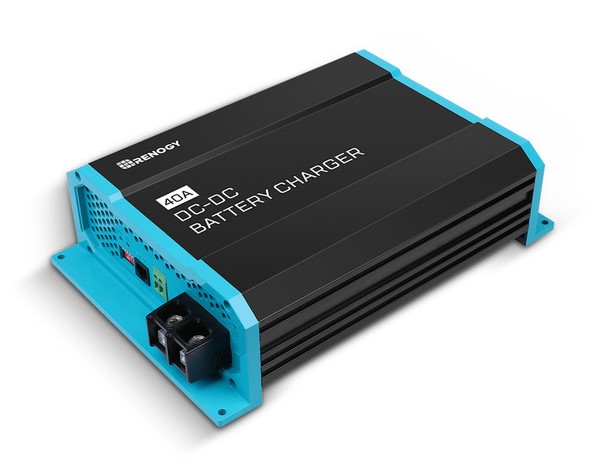




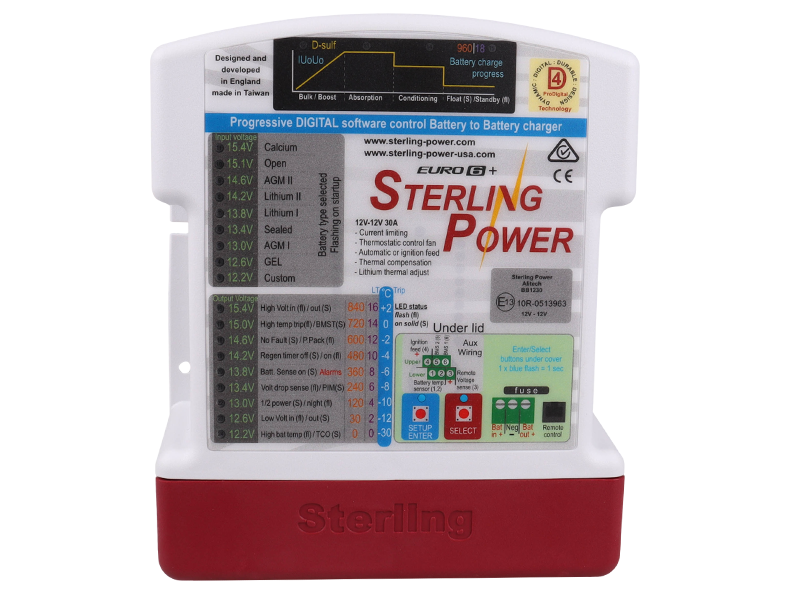



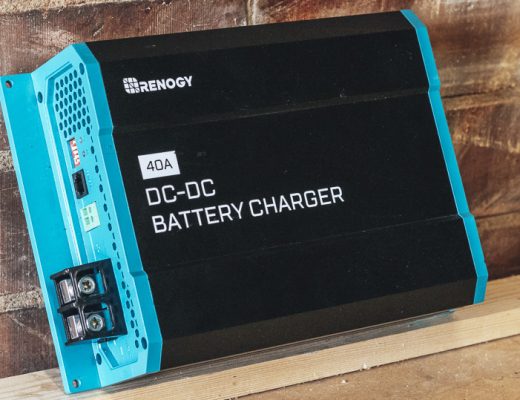

No Comments